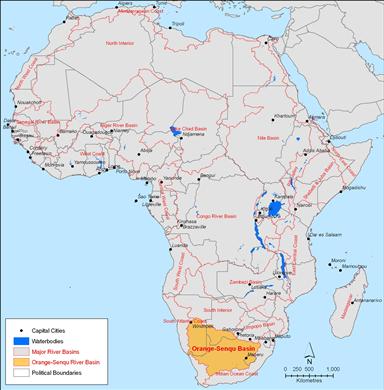Many of the world’s freshwater resources are shared by two or more countries. There are over 263 transboundary river basins in the world, a third of which are shared by more than two countries (Giordano & Wolf 2003). Transboundary basin catchments represent 47% of the earth’s land and 40% of the world’s population (Wolf et al.)Over 145 countries share these basins and within Africa alone, there are 63 transboundary river basins.

The major river basins of the African continent.
Source:Hatfield 2009
( click to enlarge )
A river basin represents a unified hydrologic and geographic unit, which supports a holistic perspective on river basin management. River Basin Organisations (RBOs) have been promoted as the most appropriate means to manage water resources under some form of supra-national authority (Johnston 2009). This in-turn supports the approach of Integrated Water Resource Management (IWRM), which has been proposed under international water law.
Transboundary river basin organisations provide a framework for managing water resources across national boundaries. Other critical institutional responses to address some present-day water challenges include commitment to international treaties, effective national water laws and regulations governing access and use of water, and creation of a knowledge-base for basin managers to make informed decisions.
At the International level, UN Convention on the Law of the Non-Navigational Uses of International Watercourses (UN Convention) provides a framework and principles to guide basin level agreements. Within the Southern African Development Community (SADC), transboundary water management shoudl be considered within the context of riparian nations membership to SADC (GEF 2008). The Revised SADC Protocol on Shared Watercourses (Revised Protocol) is an example of a legal instrument at the regional level, stipulating rules and regulations for members of SADC. At the basin level, the Orange-Senqu River Basin Commission was the first basin commission to be established following the regional ratification of the Revised Protocol (Böge 2006).
The Orange-Senqu River Commission (ORASECOM) was established in 2000 to promote the equitable and sustainable development of the resources of the Orange-Senqu River shared by Botswana, Lesotho, Namibia and South Africa. The Orange-Senqu River Basin is highly developed, with many dams and transfer schemes, creating a critical need for cooperative management between riparian states.
Box: Transboundary Rivers within SADC
There are 13 continental member states in the Southern African Development Community (SADC) which share 15 international rivers. South Africa, the most diversified economy in the SADC, shares six international watercourse systems with its neighbouring states. The four most important basins are the Incomati, Limpopo, Maputo and Orange, which are shared with Botswana, Lesotho, Mozambique, Namibia, Swaziland and Zimbabwe (see Table 1) as part of what is being referred to as a Hydro-political Complex (Ashton & Turton, 2007). The area of the four transboundary basins covers about 1.5 million km² or about 37% of the total area of the seven basin states. The rivers have a total mean annual runoff (MAR) of 23 000 million cubic metres per annum (Hirji et al., 2002), but the availability of water is under increasing pressure due to escalating developmental demands in each of the respective basin states.
Source: Pieter et al. 2008
